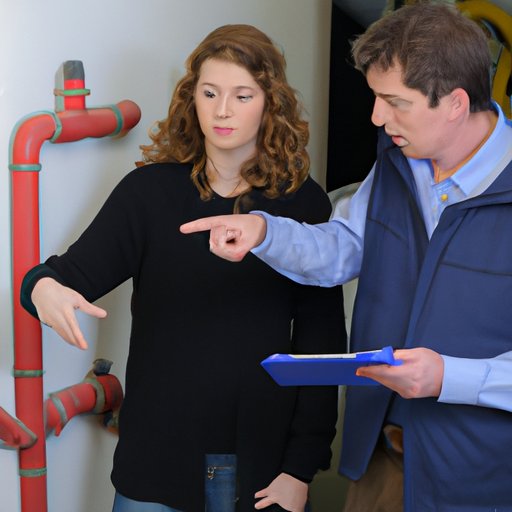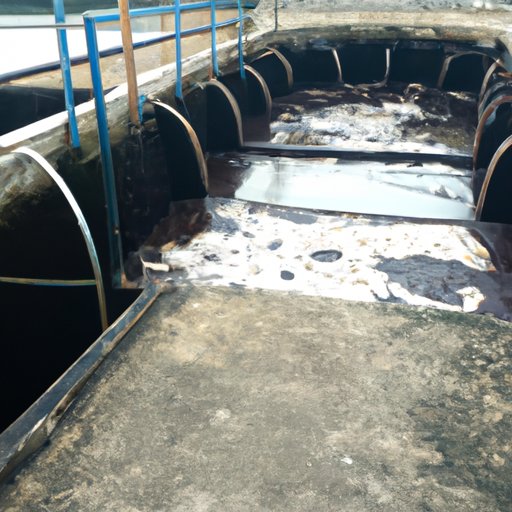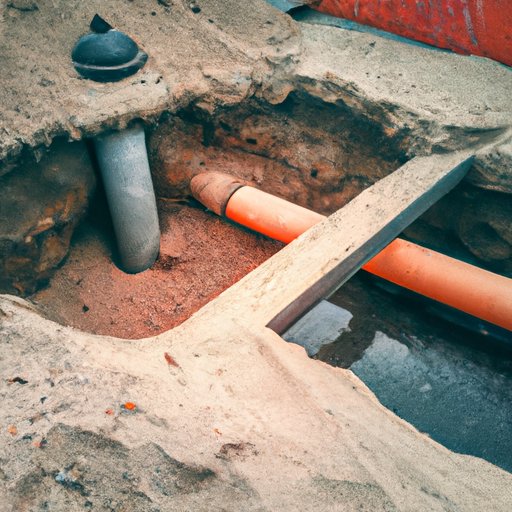Introduction
A sewer system is a critical part of our infrastructure that is often taken for granted. We don’t think about it until something goes wrong – but when it does, it can be a major problem. In this article, we will explore how a sewer system works, from the collection of wastewater to the treatment process and finally, the maintenance requirements to keep it working properly.

Explaining the Basics of Sewer Systems
Sewer systems are responsible for collecting and transporting wastewater from homes and businesses to a treatment plant. Wastewater is defined as any liquid or solid waste produced by households and businesses, including toilet waste, shower water, and industrial waste. This wastewater is collected through a network of underground pipes and transported to a treatment facility, where it is processed and cleaned before returning to the environment.
There are two main types of sewer systems: combined and separate systems. Combined systems transport both domestic and industrial wastewater to the same treatment facility, while separate systems have dedicated facilities for each type of wastewater.

Understanding the Process of Wastewater Treatment
Once the wastewater has been collected and transported to a treatment facility, it goes through a series of treatments to remove contaminants and reduce pollutants. The three main stages of wastewater treatment are primary, secondary, and tertiary.
Primary treatment removes large particles from the wastewater, such as dirt, debris, and organic matter. This is done using screens and settling tanks. Secondary treatment further reduces pollutants by using biological processes such as aeration and filtration. Finally, tertiary treatment uses a variety of methods to remove bacteria, viruses, and other pathogens.
Examining the Different Components of a Sewer System
A sewer system is made up of several different components, all of which work together to collect and transport wastewater. These components include pipes, manholes, catch basins, and septic tanks.
Pipes are the backbone of any sewer system. They are typically made of PVC, cast iron, or clay and come in various sizes and lengths. Pipes are laid out in a grid-like pattern to connect homes and businesses with the main sewer line.
Manholes are access points located along the pipe network. They allow maintenance workers to inspect and repair the pipes if needed. Catch basins are used to collect surface runoff from roads and sidewalks and direct it into the sewer system.
Finally, septic tanks are large underground tanks used to store wastewater from homes and businesses that are not connected to the main sewer line. Septic tanks use natural bacteria to break down solids and release the liquid into the ground.

Describing How Sewers Connect to Homes and Businesses
Homes and businesses are connected to the main sewer line via a lateral line. Lateral lines branch off from the main line at regular intervals and run directly to individual properties. Each property has its own cleanout access point, which allows maintenance workers to inspect and clear blockages if needed.
It is important to keep sewer lines clear of any obstructions, such as tree roots or foreign objects. Blockages can cause backups and overflows, resulting in costly repairs. Homeowners should also avoid pouring grease, oil, and other solid materials down their sinks, as these can cause clogs.
Investigating the Role of Septic Tanks in Sewer Systems
Septic tanks are used in areas where there is no connection to the main sewer line. They are large underground tanks that collect wastewater from homes and businesses and use natural bacteria to break down solids. The liquid is then released into the ground, where it is filtered and absorbed by the soil.
Septic tanks require regular maintenance to ensure they are working properly. This includes emptying the tank periodically, checking for leaks, and inspecting the drain field. It is also important to avoid putting any non-biodegradable materials, such as plastics or diapers, into the septic tank.
Outlining the Maintenance Requirements of Sewer Systems
To ensure a sewer system is working properly, it is important to maintain it on a regular basis. This includes regular inspections to check for damage or blockages, avoiding clogs by not pouring grease and oil down the sink, and dealing with backups quickly to prevent further damage. Additionally, homeowners should have their septic tanks emptied regularly and inspected for leaks and other issues.
Conclusion
Sewer systems are an integral part of our infrastructure, and it is important to understand how they work and the maintenance requirements to keep them running smoothly. By understanding the basics of a sewer system, the components that make it up, and the treatment process, we can help ensure these systems are working properly and efficiently.
(Note: Is this article not meeting your expectations? Do you have knowledge or insights to share? Unlock new opportunities and expand your reach by joining our authors team. Click Registration to join us and share your expertise with our readers.)
